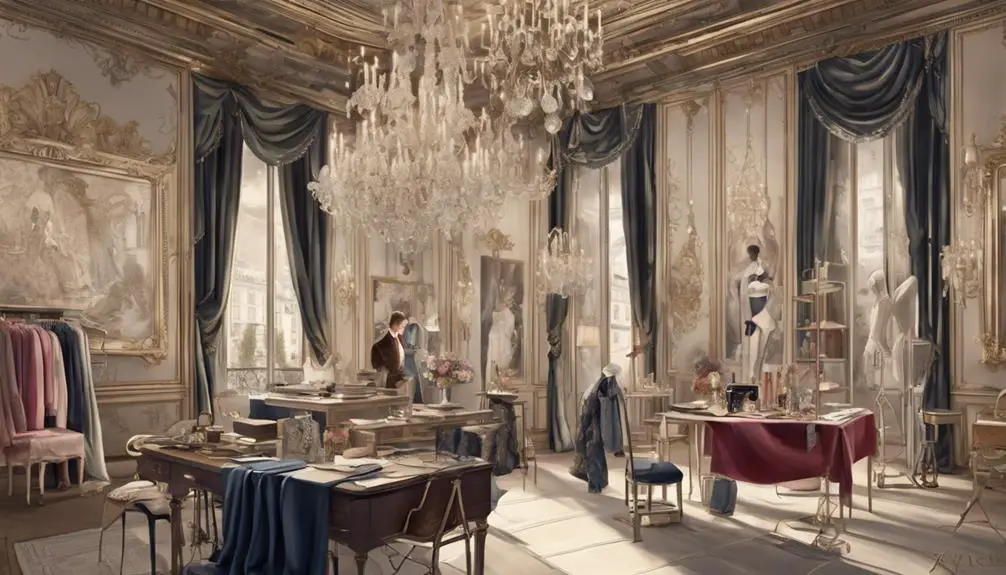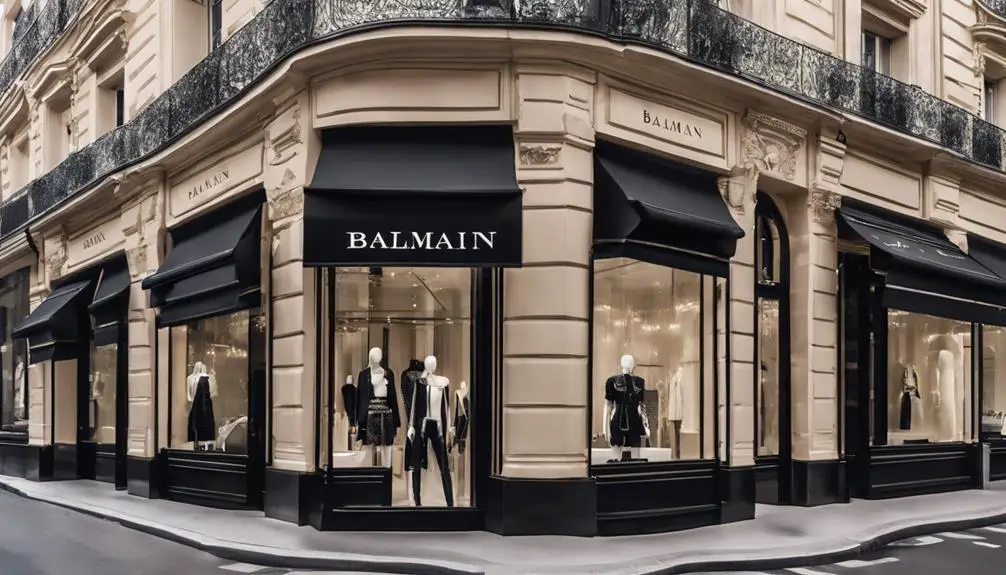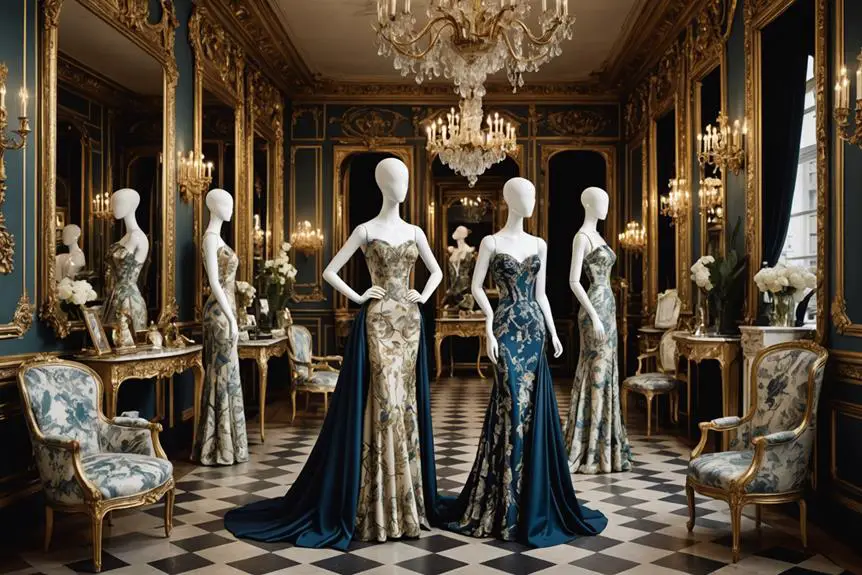The House of Balmain was founded in 1945 by Pierre Balmain, who sought to revive glamour in a post-war world. His first collection introduced the "New French Style," emphasizing femininity through luxurious fabrics and tailored designs like nipped-in waists and full skirts. Celebrities quickly embraced Balmain, enhancing its status. Over the years, designers like Erik Mortensen and Olivier Rousteing expanded its reach and modernized its aesthetic to appeal to younger audiences. Today, Balmain reflects elegance and empowerment while continuing to shape trends in the fashion world. There's much more to discover about its impact and evolution!
The Birth of Balmain

The birth of Balmain in 1945 marked a pivotal moment in fashion history, as Pierre Balmain launched his eponymous house shortly after Paris emerged from the shadows of war. This was a time when the city was ready to reclaim its status as a fashion capital, and Pierre's vision was both bold and invigorating.
In October 1945, he debuted his first collection, which introduced the world to the "New French Style." This innovative approach emphasized femininity, showcasing opulent designs that stood in stark contrast to the utilitarian fashion trends of the post-war era. Balmain's commitment to craftsmanship mirrored that of other influential fashion houses, which also shaped the industry during this transformative period, such as the evolution of Givenchy's early designs.
As you explore Balmain's early days, you'll notice the hallmark features that quickly garnered acclaim. Richly embroidered fabrics, nipped-in waists, and fuller skirts became synonymous with the brand, reflecting Balmain's early training at Lucien Lelong's atelier. His commitment to craftsmanship and attention to detail set Balmain apart in a crowded marketplace.
The allure of Balmain didn't just stop at the runway. Hollywood stars like Ava Gardner and Brigitte Bardot were drawn to the brand, solidifying its reputation in the fashion industry. Their celebrity endorsements helped elevate Balmain from a new label to a household name, illustrating how fashion and fame intertwined.
Through this foundation, Balmain laid the groundwork for its enduring legacy in haute couture, ensuring that the brand wouldn't only survive but thrive in the ever-evolving world of fashion.
Key Designers and Their Impact
Key designers have played a crucial role in shaping Balmain's identity and evolution over the decades.
Starting with Pierre Balmain, who founded the brand in 1945, his opulent and feminine designs defined its early vision and greatly contributed to the post-war fashion renaissance in Paris. His unique approach to luxury fashion can be compared to the vintage identification process that has become essential for discerning collectors today.
After his passing in 1982, Erik Mortensen continued this legacy, focusing on couture collections that showcased the house's traditional craftsmanship.
In the 1990s, Oscar de la Renta took the reins, bringing international acclaim to Balmain with his modest yet elegant designs, broadening the brand's global reach.
The house saw another shift under Christophe Decarnin from 2005 to 2011, who introduced a modern aesthetic that resonated with younger audiences, making Balmain more visible in the fashion world.
Then came Olivier Rousteing, who became the creative director in 2011 at just 25 years old. His social media-savvy approach revolutionized Balmain, integrating Asian influences and greatly enhancing the brand's contemporary appeal.
Under his direction, Balmain solidified its brand identity, capturing the attention of a new generation.
Here's a quick summary of their impact:
- Pierre Balmain: Established the brand's identity and femininity.
- Oscar de la Renta: Expanded global reach and garnered acclaim.
- Olivier Rousteing: Revolutionized modern aesthetic through social media.
Together, these designers not only shaped Balmain's past but also laid a strong foundation for its future in the fashion industry.
Expansion and Global Presence

Building on the strong foundation laid by its designers, Balmain has successfully expanded its global presence in recent years. The brand operates over 50 stores worldwide, with flagship locations in iconic cities like Paris, Tokyo, New York City, London, and Milan. The opening of the New York flagship in 2016 greatly boosted Balmain's visibility in the American market, drawing in fashion enthusiasts and celebrities alike.
This expansion didn't stop there; Balmain has recently opened new stores in Houston and Atlanta, showing its commitment to further grow its footprint in the U.S. This ambitious strategy was fueled by an investment from the Qatari firm Mayhoola, which acquired Balmain in 2016 for around €500 million. This investment has allowed Balmain to enhance its brand and focus on expansion.
A vital part of Balmain's global presence is its savvy use of digital marketing and social media. By targeting a wider audience online, the brand connects with fans and potential customers like never before. Successful campaigns and collaborations on social platforms help to keep Balmain at the forefront of contemporary fashion.
As it continues to expand into new markets and open more stores, Balmain isn't just a fashion house but a global brand that appeals to diverse audiences around the world. The combination of strategic investments and innovative marketing positions Balmain for continued success in the future.
Collaborations and Product Lines
Over the years, Balmain has tapped into various collaborations and product lines that showcase its innovative spirit and commitment to luxury. From high-fashion partnerships to licensing agreements, the brand has consistently expanded its reach in the fashion and beauty industries.
One standout moment was the collaboration with H&M in 2015. This one-off collection sold out quickly, proving that Balmain's high-fashion designs could be accessible to a broader audience. However, the brand didn't stop there; it ventured into the fragrance market with a licensing agreement with Interparfums in 2012. This move allowed Balmain to introduce luxurious scents that complemented its stylish image.
Recently, in 2022, Balmain announced a new licensing agreement with Estée Lauder Companies, further diversifying its product lines within beauty and cosmetics. Notable collaborations also include partnerships with Kylie Jenner for makeup collections, Puma featuring Cara Delevingne, and a high-fashion lingerie line for Victoria's Secret. Each of these collaborations reflects Balmain's commitment to modern trends and celebrity influence.
Here are some key highlights of Balmain's collaborations and product lines:
- The Pierre Balmain diffusion line launched in 2011, showcasing a different side of the brand.
- The successful partnership with H&M, making high-fashion accessible.
- Expanding into beauty with notable licensing agreements and celebrity collaborations.
Through these efforts, Balmain continues to shape its identity while staying relevant in the ever-evolving fashion landscape.
Cultural Significance and Legacy

The House of Balmain stands as a beacon of cultural significance in the world of fashion, having reshaped the landscape of Parisian style since its founding in 1945 by Pierre Balmain. This iconic brand revitalized fashion after World War II, establishing the "New French Style" that emphasized femininity and elegance.
Balmain's innovative designs have influenced numerous fashion houses, similar to how vintage Fendi's logo development marked a pivotal shift in branding and luxury. Your understanding of Balmain's influence deepens when you realize it caught the eye of Hollywood stars like Ava Gardner and Brigitte Bardot, who wore its stunning designs, further cementing the brand's status in both the fashion industry and popular culture.
Balmain's unique silhouettes, featuring nipped-in waists and luxurious fabrics, played a pivotal role in shaping women's fashion during the post-war era. These designs didn't just influence contemporary trends; they set the stage for future generations of designers.
You can see this legacy thriving today, especially through the brand's collaborations, like the notable partnership with H&M in 2015, which showcased Balmain's ability to resonate with a broader audience.
Under the creative direction of Olivier Rousteing, Balmain continues to honor its rich heritage while embracing modernity and inclusivity. Rousteing's vision guarantees that the essence of Pierre Balmain's craftsmanship lives on, making the brand relevant in today's ever-evolving fashion landscape.
Balmain isn't just a label; it's a cultural phenomenon that represents elegance, empowerment, and a commitment to pushing boundaries in style.




